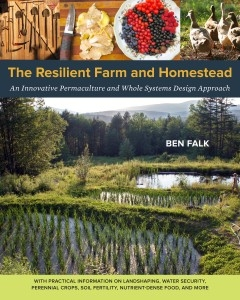The Resilient Farm and Homestead
An Innovative Permaculture and Whole Systems Design Approach
Author offers straightforward advice on how farmers and homesteaders can use the resources around them to their, and the environment’s, advantage.
Permaculture can seem like a too-large umbrella term attempting to bring together a range of concepts and strategies, and many authors have tried to articulate the discipline in an accessible way. Ben Falk stands out for this highly successful effort at addressing how farmers and homesteaders can select, design, develop, and manage resilient properties that adapt to changing environmental conditions.
Bringing his decade of experience managing a ten-acre permaculture farm in Vermont, as well as teaching about whole-systems design, Falk conveys the importance of better-designed agriculture and systems in The Resilient Farm and Homestead. Going beyond how-to advice on vegetable growing or chicken coop management, he delves into topics like fuel wood production, nutrient-dense food production, and gravity-fed water systems, which rely on moving water downhill instead of utilizing mechanical pumps. Natural strategies are emphasized, like silvopasture, a practice that combines livestock grazing and forestry to enhance soil protection and provide wind protection for animals.
Falk’s straightforward advice on topics like these—for example, with gravity-fed systems, he writes, “Gravity is free, never sleeps, and doesn’t break”—comes with a warm, friendly tone that draws the reader in and offers assurance that even the largest project is manageable, and worthy of the effort. “You already have what you need to enliven your own place and your own life,” he writes. “Inaction quickly consumes a lifetime. Be curious, be bold, pay close attention to the world in front of you. And start trying stuff.”
The material, seemingly overwhelming in scope, is presented artfully with numerous sidebars and bullet points that break information into digestible chunks. For example, a chapter on food production includes a chart on annual vs. perennial labor and input costs, a diagram of a “living security fence” made of black locust trees, and a list of storage options for harvested vegetables. Particularly compelling are a number of appendices, from a “resiliency aptitude quiz” to a crucial skill list for emergencies to a vocabulary of concepts.
Also useful, the book’s abundant photography presents a bucolic, serene series of images that make urban dwellers sigh with longing. Burlap sacks brimming with potatoes grace one page, while a lush summer garden pops from another. Farm volunteers are shown picking elderberries, raising a timber-framed wall, and grafting fruit trees. Falk also includes plenty of practical illustrations as well, such as a drawing of how to grow rice in buckets, or a diagram of a wood-heated hot water system.
The combination of these inspiring images and Falk’s deeply integrative approach provide a much-needed permaculture guide that will likely kick off an array of reader projects. The mix of resources, practical advice, and land design offered here is a strong starting point for anyone interested in regenerative agriculture and modern homesteading.
Reviewed by
Elizabeth Millard
Disclosure: This article is not an endorsement, but a review. The publisher of this book provided free copies of the book and paid a small fee to have their book reviewed by a professional reviewer. Foreword Reviews and Clarion Reviews make no guarantee that the publisher will receive a positive review. Foreword Magazine, Inc. is disclosing this in accordance with the Federal Trade Commission’s 16 CFR, Part 255.

